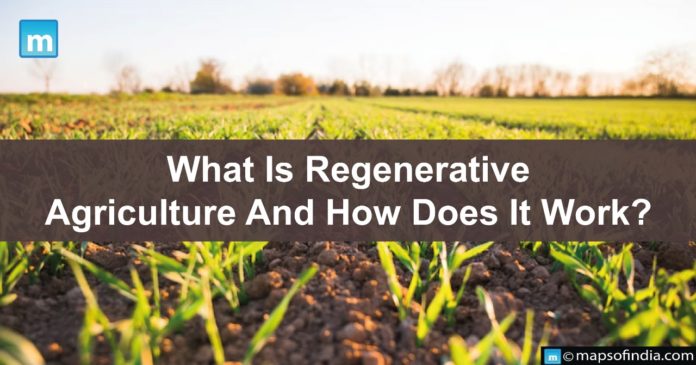Regenerative agriculture is an approach to conservative rehabilitation of food and farming ecosystem. This approach focuses on increasing biodiversity, topsoil regeneration, improving the water cycle, supporting biosequestration, enhancing ecosystem services, increasing resilience to climate change, and strengthening the vitality and health of farm soil.
To simply understand, Regenerative agriculture is a system of farming practices that tries to enhance and maintain the entire ecosystem by giving attention to soil health, water management, use of fertilizer, etc. It is a farming method that focuses on agro-ecosystem and improves the resources used while farming. It is not any specific practice of agriculture. Instead, it is a combination of a variety of sustainable agricultural techniques. Recycling resources used in farms as much as possible is a practice. It also includes the use of compost.
Origin of Regenerative Agriculture
The term ‘Regenerative Agriculture’ came into use by Rodale Institute in the early 1980s. Rodale publishing started publishing regenerative agriculture books in 1987 and 1988. Robert Rodale said,
“By marching forward under the banner of sustainability we are, in effect, continuing to hamper ourselves by not accepting a challenging enough goal. I am not against the word sustainable, rather I favor regenerative agriculture.” The term was not used by the institute in the late 1980s. It reappeared after the institute released a white paper in 2014 titled “Regenerative Organic Agricultural and Climate Change”. This paper explains agricultural practices involving crop rotation, compost application, various organic agricultural methods, etc.
Current scenario of Regenerative Agriculture
- With the expansion of the term, various books have been published on it, and several organizations have started promoting it.
- Allan Savory launched the Savory institute to educate people about large farms and different land management methods.
- A non-profit, Kiss, the Ground organization runs a series of media, education, farmland, and policy programs to make people aware of soil health and also helps and supports farmers interested in using regenerative farming methods rather than conventional ones.
- The Union and State Government of India are also promoting regenerative agriculture. They aim to reduce the chemical fertilizers and pesticides in farmlands and to lower the input costs.
India’s steps to promote regenerative agriculture
- The National Project on Organic Farming
- Systematic rice intensification
- Zero-budget natural farming, which is now known as the Subhash Palekar Natural Farming
What are the different activities taking place under regenerative agriculture?
- Dry sowing
- Change in cropping pattern
- Drip irrigation
- Soil fertility inventions
- Change in crop variety
- System of wheat intensification, Line sowing
- Sprinkler




